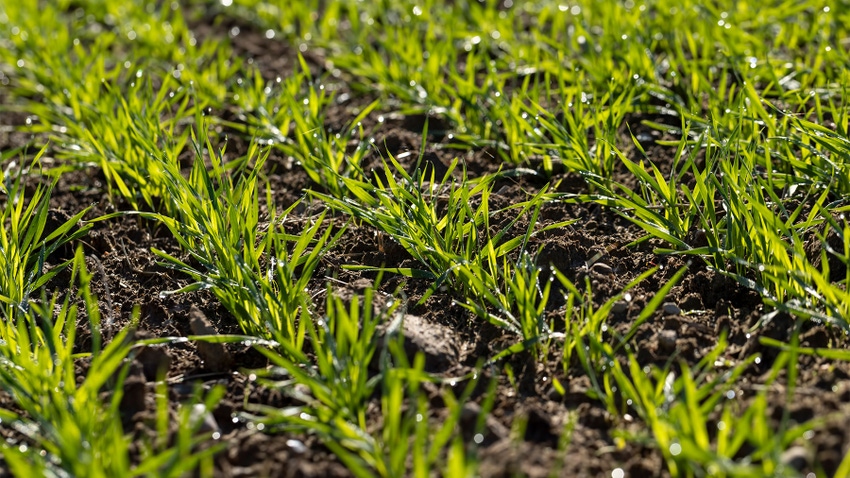March 28, 2024

by Ed Lentz
As yards are turning green, so are wheat fields — what farmers call green-up. It’s when plants have started spring growth of new leaves. A field must be completely green in color to be considered at the green-up growth stage.
It was unusual to see so much green before St. Patrick’s Day this year. This early occurrence is most likely from the strong El Niño pattern in the eastern Pacific Ocean. Previously, this pattern happened in 2016, 1998 and 1982. Greening of yards and wheat fields is about two weeks earlier than normal this year.
Farmers become actively engaged in many field activities after green-up. One of these activities is fertilizer application. Because wheat is a grass crop, it requires large amounts of nitrogen for optimal yields. Nitrogen is expensive, so farmers follow best management practices to apply only what is needed by the crop, which also benefits water quality by reducing the potential for nitrogen to enter ditches and streams. These best practices involve application timing, type of fertilizer and amount applied.
Farmers do not inject nitrogen fertilizer. This is to avoid injuring plant crowns because wheat is planted in narrow rows and vegetation is already above ground. Several decades ago, farmers would have applied fertilizer when the ground was frozen. This practice was based on convenience, but because the plants were dormant at this time, there was a considerable chance the nutrients would run off the field with rain events or thawing soil.
Wheat plants are not able to use nitrogen until new spring growth occurs, so when does wheat need nitrogen? Large demand for nitrogen does not occur until jointing. That’s when the plants switch from a vegetative growth stage to reproductive stages, with visible nodes along the stem that have a leaf attached — usually in the last week of April. However, it may be sooner because of warmer temperatures occurring now.
Avoid wheat yield losses
University research has shown that significant yield losses are likely if nitrogen application occurs after jointing. Unfortunately, extended rain may occur around jointing to prevent a timely nitrogen application. Early applications also have a greater potential for loss because the crop is only taking up a small amount at that time. However, because the wheat is growing, the potential for loss is manageable.
Thus, a compromise, and practical solution, is for farmers to apply nitrogen as soon as the soils are fit for equipment after green-up and before the crop reaches jointing. With early applications, a farmer may choose to add a compound that makes the nitrogen less prone to field losses. These are often called stabilizers. Nitrification and urease inhibitors are examples of stabilizers. This is an additional input cost, so the farmer must consider whether the risk is great enough to justify the extra expense.
Nitrogen fertilizers for wheat will be in a dry or liquid form. Urea is the most common dry form and urea-ammonium nitrate, a.k.a. 28%, is the liquid form. An advantage of liquids is that other chemicals such as herbicides can be added to the mix. It is also easier to apply a liquid more uniformly than a dry form. These products require different types of equipment for application. Thus, the farmer may decide which form to use based on the equipment available. However, the cost of the fertilizer type heavily ways on their final decision.
Besides application timing and nitrogen form, farmers can carefully determine the amount of fertilizer needed for a given field based on university recommendations. By providing an expected yield for these recommendations, often called yield goals, there are many ways to estimate yield potential. A common method is to review yields from the past five years, throw out the highest and lowest years, and then average the remaining three years to determine yield goal. The yield goal can be matched to a nitrogen rate curve to determine the amount of nitrogen needed.
Nitrogen rate curves have been completed by Ohio State University research to determine the amount of nitrogen needed to obtain a certain yield. These rates can be found in Extension Bulletin 974, Tri-State Fertilizer Recommendations for Corn, Soybean, Wheat and Alfalfa. Recommendations do not allow nitrogen credits for the previous soybean or cover crop. However, they do recommend subtracting any nitrogen applied prior to planting.
The typical application will be around 20 pounds of nitrogen per acre at or before planting. Thus, the recommendation for a 100-bushel wheat crop is 120 pounds of total nitrogen per acre minus the 20 pounds from the fall, giving a spring nitrogen rate of 100 pounds.
Wheat fields have come out of their winter hibernation early this year because of the abnormally warm March temperatures. Fertilizer applications may come earlier.
Lentz is an agriculture and natural resources educator with the Ohio State University Extension office in Hancock County.
Read more about:
FertilizerYou May Also Like




